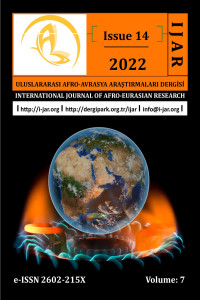Öz
Showing great similarities in terms of their geography, size, economic
structure, development and demography, Estonia, Lithuania and Latvia, which are called the Baltic
States, have positioned themselves on the side of the Western system, as a part of it, with the
collapse of the Soviet Union, under whose rule they lived for many years. While restructuring their
economic, cultural and political structure as members of the European Union, these states have
determined their military and security structure as members of NATO. It was clear that while these
three Baltic States were integrating into the Western system with all their structures, they would
naturally face some difficulties. Therefore, adaptation studies have encountered different levels of
difficulties and obstacles in each state. For this reason, there were different consequences of being
involved in both structures. It is also seen that although each state is referred to by one name and
has different dynamics, similar conclusions cannot be reached when integration is completed in
these three countries. The purpose of this study is to examine the “positive and negative”
developments in the economic, cultural, political and military fields of the EU and NATO
memberships in the mentioned states.
Anahtar Kelimeler
Kaynakça
- Aleksandraviciute, Edita (2006). Avrupa Birliği Üyelik Sürecinde Litvanya, (Yayımlanmamış yüksek Lisans tezi, T.C. İstanbul Üniversitesi Sosyal Bilimler Enstitüsü, İstanbul.
- Balcı, M. (2002). Comparative Analysis of Baltic States’ Membership to the EU, (Yayımlanmamış yüksek Lisans Tezi). Marmara Üniversitesi, Avrupa Topluluğu Enstitüsü, İstanbul.
- Demirtaş, İ. (2020). Baltık Ülkelerinin AB’ye Entegrasyon Sürecinde Rusya Faktörü, (Yayımlanmamış yüksek Lisans Tezi). İstanbul Üniversitesi Sosyal Bilimler Enstitüsü, İstanbul.
- Eravcı, A. (2020). Estonya Tarihinin Güncel Eston Dış Politikası Etkisi, Academic Social Resources Journal 5(19), 710-724.
- Kerikmäe, T., Chochia, A. ve Atallah, M. (2018). The Baltic States in the European Union, Oxford Research Encyclopedia of Politics, 1-27. Erişim adresi: https://www.researchgate.net/publication/324945358_The_Baltic_States_in_the_European_Union.
- KFA Fuarcılık, Global Fair Agency. (2020). Yeni Normale Göre Baltık Bölgesi Raporu, Litvanya, Letonya, Estonya. Erişim adresi: http://www.salihlitso.org.tr/uploaded/dosyalar/YEN%C4%B0NORMALEG%C3%96REBALTIKB%C3%96LGES%C4%B0RAPORU2020.pdf
- Miniotaitė, Gražina (2011). Europeanization Tendencies of the Foreign and Security Policy of the Baltic States, Lithuanian Annual Strategic Report, 9, (1), 101-119.
- Skilling, D. (2018). The Baltic Sea Region Economies Report: Progress and Priorities- A 20-year perspective. Erişim adresi: http://www.bdforum.org/wp-content/uploads/2018/04/TBSREReport2018_210x297_webfinal.pdf
- Spurga, S. (2007). Europenization of Civil Society in The Baltic States: Promotion or Constraint of Democratization? Vieðoji Politika Ir Administravimas, 22, 57-67. Erişim adresi: https://www.researchgate.net/publication/309266960_Europeanization_of_Civil_Society_in_the_Baltic_States_Promotion_or_Constraint_of_Democratization
Öz
Coğrafyaları, büyüklükleri, ekonomik yapıları, kalkınmaları ve demografileri açısından büyük benzerlikler gösteren ve Baltık Devletleri olarak nitelenen Estonya, Litvanya ve Letonya, uzun yıllar egemenliği altında yaşadıkları Sovyetler Birliği’nin dağılmasıyla, kendilerini Batı sisteminin yanında, onun bir parçası olarak konumlandırmışlardır. Bu devletler ekonomik, kültürel ve siyasal yapılarını Avrupa Birliği’ne üye olarak yeniden konumlandırırken, askeri ve güvenlik yapılarını NATO üyeliği yoluyla belirlemişlerdir. Bu üç Baltık Devleti tüm yapılarıyla Batılı sisteme entegre olurlarken bazı zorluklarla karşılaşacakları öngörülmüştür. Bundan dolayı, uyum çalışmaları her bir devlette farklı seviyelerde güçlük ve engellerle karşılaşmıştır. Bu sebepledir ki, her iki yapıya dahil olmanın değişik sonuçları da ortaya çıkmıştır. Her bir devletin farklı dinamiklerinin olduğu ve tek isim ile anılmalarına rağmen, bu üç ülkede entegrasyon tamamlandığında benzer sonuca varılamadığı da görülmektedir. Bu çalışmanın amacı, AB ve NATO üyeliklerinin bahsedilen devletlerde ekonomik, kültürel, siyasal ve askeri alanlarda ne gibi olumlu-olumsuz gelişmelere yol açtığının incelenmesidir.
Anahtar Kelimeler
Kaynakça
- Aleksandraviciute, Edita (2006). Avrupa Birliği Üyelik Sürecinde Litvanya, (Yayımlanmamış yüksek Lisans tezi, T.C. İstanbul Üniversitesi Sosyal Bilimler Enstitüsü, İstanbul.
- Balcı, M. (2002). Comparative Analysis of Baltic States’ Membership to the EU, (Yayımlanmamış yüksek Lisans Tezi). Marmara Üniversitesi, Avrupa Topluluğu Enstitüsü, İstanbul.
- Demirtaş, İ. (2020). Baltık Ülkelerinin AB’ye Entegrasyon Sürecinde Rusya Faktörü, (Yayımlanmamış yüksek Lisans Tezi). İstanbul Üniversitesi Sosyal Bilimler Enstitüsü, İstanbul.
- Eravcı, A. (2020). Estonya Tarihinin Güncel Eston Dış Politikası Etkisi, Academic Social Resources Journal 5(19), 710-724.
- Kerikmäe, T., Chochia, A. ve Atallah, M. (2018). The Baltic States in the European Union, Oxford Research Encyclopedia of Politics, 1-27. Erişim adresi: https://www.researchgate.net/publication/324945358_The_Baltic_States_in_the_European_Union.
- KFA Fuarcılık, Global Fair Agency. (2020). Yeni Normale Göre Baltık Bölgesi Raporu, Litvanya, Letonya, Estonya. Erişim adresi: http://www.salihlitso.org.tr/uploaded/dosyalar/YEN%C4%B0NORMALEG%C3%96REBALTIKB%C3%96LGES%C4%B0RAPORU2020.pdf
- Miniotaitė, Gražina (2011). Europeanization Tendencies of the Foreign and Security Policy of the Baltic States, Lithuanian Annual Strategic Report, 9, (1), 101-119.
- Skilling, D. (2018). The Baltic Sea Region Economies Report: Progress and Priorities- A 20-year perspective. Erişim adresi: http://www.bdforum.org/wp-content/uploads/2018/04/TBSREReport2018_210x297_webfinal.pdf
- Spurga, S. (2007). Europenization of Civil Society in The Baltic States: Promotion or Constraint of Democratization? Vieðoji Politika Ir Administravimas, 22, 57-67. Erişim adresi: https://www.researchgate.net/publication/309266960_Europeanization_of_Civil_Society_in_the_Baltic_States_Promotion_or_Constraint_of_Democratization
Ayrıntılar
| Birincil Dil | Türkçe |
|---|---|
| Bölüm | Makaleler |
| Yazarlar | |
| Erken Görünüm Tarihi | 16 Ağustos 2022 |
| Yayımlanma Tarihi | 30 Haziran 2022 |
| Yayımlandığı Sayı | Yıl 2022 Cilt: 7 Sayı: 14 |
All rights reserved. International Journal of Afro-Eurasian Research (IJAR) is an International refereed journal and published biannually. Authors are responsible for the content and linguistic of their articles. Articles published here could not be used without referring to the Journal. The opinions in the articles published belong to the authors only and do not reflect those of International Journal of Afro-Eurasian Research.


